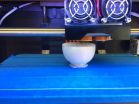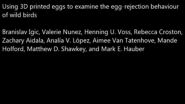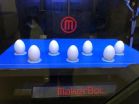Brood parasites are birds that don't build nests of their own. Instead, they slip their eggs into the nests of other species, where oblivious parents may raise these invading chicks even at the expense of their own. In some species, this has led to an evolutionary arms race in which host parents get better and better at identifying and rejecting eggs that aren't theirs, using cues including egg size, shape, color, and pattern, while brood parasites have become increasingly adept at mimicking the eggs of their host species. To study egg rejection behavior and figure out how bird parents identify impostor eggs, ornithologists have long been doing experiments which involve adding artificial eggs to nests and observing what the parents do.
The problem is that making convincing, uniform artificial eggs out of traditional materials like plastic, wood, and plaster-of-Paris is surprisingly challenging. The fake eggs can be time-consuming to produce, prone to human error, and hard for other researchers to replicate exactly, which is important in confirming scientific findings. To get around these limitations, researchers created digital models of the eggs of Brown-headed Cowbirds (a North American brood parasite) and created them using 3D printers. 3D printing also allowed for the creation of hollow eggs that could be filled with water or gel, closely mimicking not just the weight but even the thermodynamic properties of real eggs.
Painted beige to match real cowbird eggs or blue-green to match the eggs of the host American robins, the 3D printed eggs were placed in robin nests, which were then monitored for six days to see how the parents reacted. Robins accepted 100% of the blue-green eggs but rejected 79% of the eggs which were painted to resemble those of cowbirds. Reassuringly, this is similar to the results of past studies using traditionally-produced plaster eggs, however 3D printed eggs now have the advantage of being less variable and more able to reproduce a desired size and shape. In addition, the digital models used to produce them can be shared among researchers so that experiments can be replicated more precisely than was possible in the past.
"Hosts of brood parasites vary widely in how they respond to parasitic eggs, and this raises lots of cool questions about egg mimicry, the visual system of birds, the ability to count, cognitive rules about similarity, and the biomechanics of picking things up," says Prof. Don Dearborn, chair of the Biology Department at Bates College, a brood parasitism expert who was not involved in the 3D printing study. "For decades, tackling these questions has meant making your own fake eggs -- something we all find to be slow, inexact, and frustrating. This study uses 3D printing for a more nuanced and repeatable egg-making process, which in turn will allow more refined experiments on host-parasite coevolution. I'm also hopeful that this method can be extended to making thin-shelled, puncturable eggs, which would overcome another one of the constraints on these kinds of behavioral experiments."
"3D printing technology is not just in our future -- it has already revolutionized medical and basic sciences," says Prof. Mark Hauber, an animal behaviorist at Hunter College of the City University of New York, the study's senior author. "Now it steps out into the world of wild birds, allowing standardized egg rejection experiments to be conducted throughout the world."
INFORMATION:
Media:
Video 1: For a timelapse video of a 3D model egg being printed, visit: https://www.youtube.com/watch?v=9chbvkvG2vY
Video credit: Hunter College, CUNY Communication Office
Email press@peerj.com if you need a downloadable copy
Video 2: For a video of a robin rejecting a 3D model egg (Supplemental File 1 from the article), visit: https://youtu.be/9JPh8hkPTlU
Video credit: Mark Hauber
Email press@peerj.com if you need a downloadable copy
Video 3: For a shorter video of a robin rejecting a 3D model egg visit: http://www.tinyurl.com/robinreject
Video credit: Mark Hauber
Email press@peerj.com if you need a downloadable copy
EMBARGOED until May 26th 2015: 7 am EDT; 11 am UTC (i.e. the date of publication)
PDF of this Press Release: http://static.peerj.com/pressReleases/2015/PressReleasePeerJ_Igic.pdf
Link to the Press Preview of the Original Article (this link should only be used BEFORE the embargo ends): http://static.peerj.com/press/previews/2015/05/965.pdf. Note: this is an author proof and so may change slightly before publication.
Link to the Published Version of the article (quote this link in your story - the link will ONLY work after the embargo lifts): https://peerj.com/articles/965 - your readers will be able to freely access this article at this URL.
Citation to the article: Igic B, Nunez V, Voss HU, Croston R, Aidala Z, Lopez AV, Van Tatenhove A, Holford ME, Shawkey MD, Hauber ME (2015) Using 3D printed eggs to examine the egg-rejection behaviour of wild birds. PeerJ 3:e965 https://dx.doi.org/10.7717/peerj.965
About PeerJ:
PeerJ is an Open Access publisher of peer reviewed articles, which offers researchers a lifetime publication plan, for a single low price, providing them with the ability to openly publish all future articles for free. PeerJ is based in San Francisco, CA and London, UK and can be accessed at https://peerj.com/. PeerJ's mission is to help the world efficiently publish its knowledge.
All works published in PeerJ are Open Access and published using a Creative Commons license (CC-BY 4.0). Everything is immediately available--to read, download, redistribute, include in databases and otherwise use--without cost to anyone, anywhere, subject only to the condition that the original authors and source are properly attributed.
PeerJ has an Editorial Board of over 1,000 respected academics, including 5 Nobel Laureates. PeerJ was the recipient of the 2013 ALPSP Award for Publishing Innovation.
PeerJ Media Resources (including logos) can be found at: https://peerj.com/about/press/
Media Contacts:
External Expert who may be consulted: Prof. Don Dearborn, Chair, Dept. Biology, Bates College: ddearbor@bates.edu
For the authors: Prof. Mark Hauber; mhauber@hunter.cuny.edu ; +1 917-455-2607
For PeerJ: email: press@peerj.com , https://peerj.com/about/press/
Note: If you would like to join the PeerJ Press Release list, visit: http://bit.ly/PressList
Abstract (from the article):
The coevolutionary relationships between brood parasites and their hosts are often studied by examining the egg rejection behaviour of host species using artificial eggs. However, the traditional methods for producing artificial eggs out of plasticine, plastic, wood, or plaster-of-Paris are laborious, imprecise, and prone to human error. As an alternative, 3D printing may reduce human error, enable more precise manipulation of egg size and shape, and provide a more accurate and replicable protocol for generating artificial stimuli than traditional methods. However, the usefulness of 3D printing technology for egg rejection research remains to be tested. Here, we applied 3D printing technology to the extensively studied egg rejection behaviour of American robins, Turdus migratorius. Eggs of the robin's brood parasites, brown-headed cowbirds, Molothrus ater, vary greatly in size and shape, but it is unknown whether host egg rejection decisions differ across this gradient of natural variation. We printed artificial eggs that encompass the natural range of shapes and sizes of cowbird eggs, painted them to resemble either robin or cowbird egg colour, and used them to artificially parasitize nests of breeding wild robins. In line with previous studies, we show that robins accept mimetically coloured and reject non-mimetically coloured artificial eggs. Although we found no evidence that subtle differences in parasitic egg size or shape affect robins' rejection decisions, 3D printing will provide an opportunity for more extensive experimentation on the potential biological or evolutionary significance of size and shape variation of foreign eggs in rejection decisions. We provide a detailed protocol for generating 3D printed eggs using either personal 3D printers or commercial printing services, and highlight additional potential future applications for this technology in the study of egg rejection.


